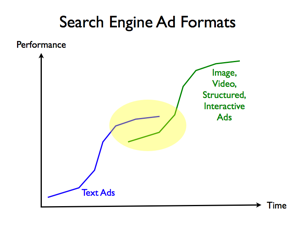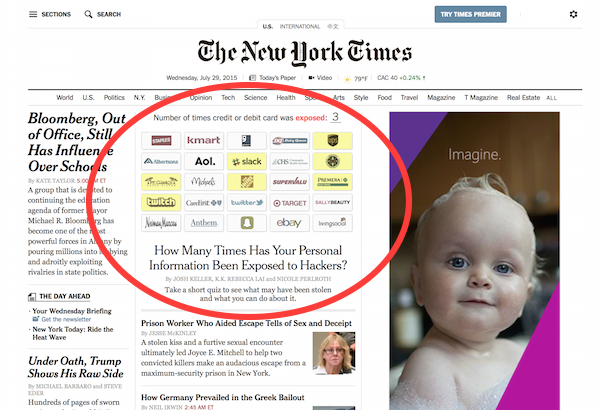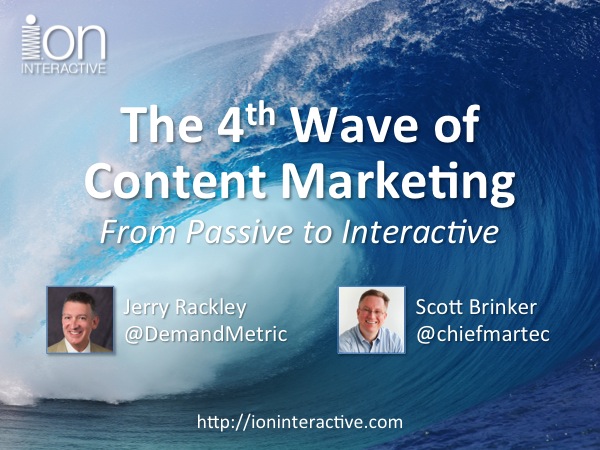Are we on the verge of a new S curve for search engine advertising?

S curves are a phenomenon of technology adoption. They begin where a particular technology — in this case, ads on search engine results pages (SERPs) — arrive on the scene with chaotic, slow growth while early adopters figure it out. Then a dominant model emerges — e.g., Google AdWords text ads — where the winning approach and the benefits to the market become obvious, powering mainstream adoption at an exponential rate. But eventually growth levels off, adoption saturates, and incremental improvements and benefits plateau.
At this point, new technologies, approaches, and business models vie in the same space to be the “the next new thing” — to trigger a new S curve that will overtake the old one.
The beginning of this new S curve is again chaotic and slow: lots of ideas, many of which will fail, many of which are initially not as effective as the dominant winner in the old S curve. There’s usually resistance from people on the old S curve, who have mastered that game and are reluctant to have the rules change. When you’re used to something, especially something on which your livelihood is based, it can be hard to imagine something different.
But the forces of entrepreneurial ferment and early adopter incentives conspire to push past that skepticism and uncover the winners of the new S curve. Once they crystallize, and the new value proposition comes into focus for everyone else, people jump from the old curve to the new curve, and the new dominant model takes off at exponential speed.
And the cycle of disruptive innovation continues.
Recent events make me wonder if a new S curve is soon to emerge for search engine ads:

1. Growth in US online ad spending is slowing. A recent eMarketer article reported that, in particular, “comScore data shows a second straight month of slower growth in paid clicks for Google’s main ad-serving business.” Now growth is still growth, and given the talk of recession, a slowing of search ad budgets may be a temporary blip. But it’s also consistent with the hypothesis that search engine ads are nearing the top of their S curve. Since “paid click measurement is critical for Google” financially, they have strong motivation to find the next catalyst of growth.
2. The Google Operating System and Digital Inspiration blogs recently captured screen shots of tests Google is running to include video ads alongside select search results. The interface is cautious about maintaining Google’s minimalist design standards: ads with accompanying videos have a small button with a plus sign that can be expanded to watch a commercial or testimonial.

Although this isn’t a huge surprise — Google had previously announced its intention to try this, with commentary from Danny Sullivan’s SearchEngineLand and the Mashable blog back in February — it sets the stage for a major shift in the concept of search engine marketing. There’s a big difference between 130 characters of stand-alone plain text and 130 characters of plain text as an introduction to a 30-second video spot.
Whether this particular ad format takes hold or not, it signals Google’s intention to experiment with new advertising ideas in their previously sacrosanct SERP interface. Marissa Mayer of Google told the New York Times that the company would explore adding small thumbnail photos to the video ads as well as considering other formats that may include ads with images. That’s a momentous shift.
3. Yahoo’s plan to render structured semantic web information in its organic search results. This will no doubt have a major impact on search engine optimization (SEO) practices, a movement I describe as SEO + Semantic Web = SEO++. However, once you set the example for how organic search results with a structured interface are more attractive and useful than plain old text summary results, it’s not too much of a stretch to visualize the same for paid search ads.
4. Google’s completed acquisition of DoubleClick. As a story on BetaNews pointed out, up until now, Yahoo! and Microsoft have left Google in the dust with regard to display advertising. Now, with DoubleClick officially in the fold, analysts expect Google’s display ad sales to be going up exponentially. That’s going to put pressure on them to grow display ad opportunities — as well as to find synergies between their businesses that extend beyond being complementors in independent areas.
5. At last month’s SES NY show — a gathering of professional search engine marketers — I was struck by how much mileage search marketers have squeezed out of a 25 character headline, two 35 character lines of text, and one 35 character display URL. People are running whole careers based around a canvas of 130 characters of plain text. Yet while I was impressed by how much nuance they’ve extracted from so little, it also seemed that the curve of innovation with text ads is nearing its upper bound. After listening to a panel of senior executives debate the use of the word “free” versus “complimentary” for 20 minutes, it’s hard not to conclude that the bottom of the barrel is near.
6. Recognition of the value of brand marketing — including exposing an audience to your brand before they’re ready for a direct interaction — is on the rise (again). Although search marketers and brand advertisers have come up with novel ways to engage brand development in search engine text ads, it’s like trying to cut a steak with a spoon. Brand marketing may still represent a huge market of “non-consumption” for search engine advertising as it exists today. Incorporating images and video in search ads could be the catalyst for a flood of brand spending in this channel.
7. Entrepreneurial creativity continues to push the boundaries of alternate search engines. Under the shadow of the Google, Yahoo!, and Microsoft search mountains, a plethora of new search sites continue to blossom. Take a look at Alt Search Engines and their Top 100 list. Vertical specialization, social search, and new visual interfaces distinguish these upstarts. But innovation in the search experience also opens the door for innovation in search advertising. This is a Petri dish from which new search ad formats may likely evolve — and eventually be adopted by the giants.
Add these pieces together:
- the search engine text ad S curve starting to level off;
- strong financial incentives for unleashing the next S curve;
- a cauldron of new search ad formats beginning to bubble;
…and it sure seems that conditions are right for a new S curve.
The implication for marketers — and marketing technologists in particular &mdash is to be ready, alert, and open-minded. When a new S curve surfaces in an industry, reaction speed and flexibility are competitive advantages. As the environment changes, it can be a valuable edge to experiment, learn, and adapt before your competitors do. This is what it means to view marketing as a science.
If image-based ads and/or video are predictably an integral part of this next wave, you can take a few steps to prepare that are either low-cost or valuable in their own right:
- put your digital asset management house in order;
- shore up your internal or external design resources;
- start to talk with new vendors in the micro-video space;
- don’t let your search marketing processes get too rigid;
- if purchasing or building search management software, make sure that you have contingency options in case significant changes are required quickly — or if even an alternate solution may need to be substituted over the next 12-24 months.
This will certainly offer a new round of upheaval for software vendors and agencies in the search marketing space. New entrepreneurs: take heed. And to the degree that this next S curve has more visual canvas than plain text ads, it may offer one more chance for traditional (or “tradigital”) advertising agencies to play a leading role in the search marketing space.
S curves do look a little like roller coasters, don’t they? Should be fun.



Great article, Scott – thanks!
Hi Scott, do you think mobile marketing is a new S-curve and has Yahoo missed the ship with their traditional web-based content and advertising?